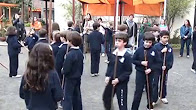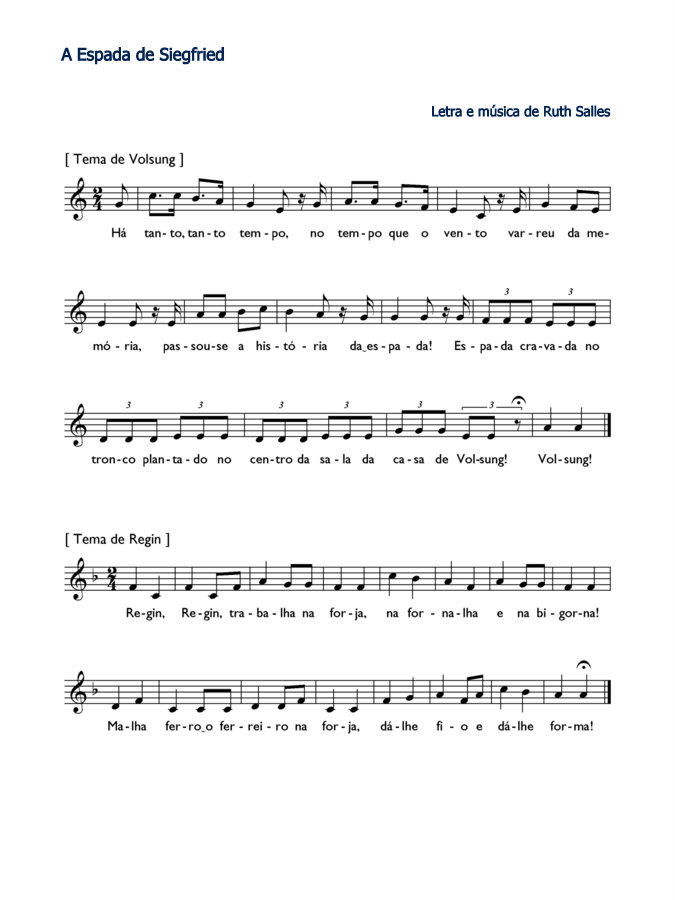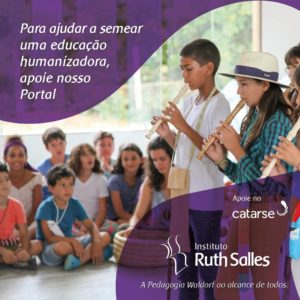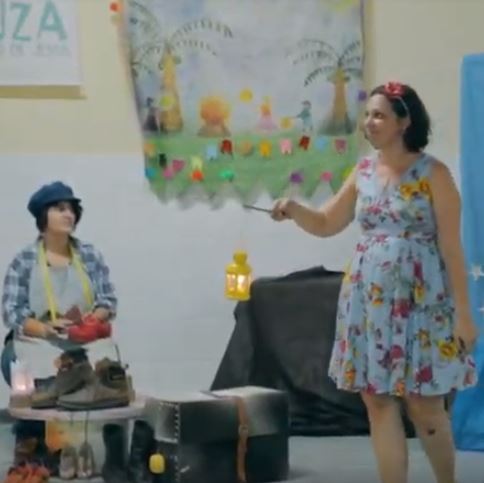 Ruth Salles' play on a Germanic myth
Ruth Salles' play on a Germanic myth
This play tells an excerpt from the Germanic myth¹ of the hero Siegfried, when he is educated by the dwarf Regin (pronounced Rêguin) and fights the dragon Fafnir to recover the dwarves' treasure. Finally, he frees the maiden who sleeps surrounded by fire.
This myth has to do with the path of the human being, who goes out through the forest of the world, develops his mind (the big head of the dwarf), dominates his emotional side, his passions (the dragon), recovering the treasure of the dwarves, who are , in fact, the knowledge accumulated by the mind. Only then can he meet his soul, his true essence (the maiden). In this part of the play, the verses from the work of the dwarves are an exercise in diction and also serve to develop the will, in the strength of the consonants.
The video below shows a 4th grade class performing a rhythm exercise with text from the play. A very interesting variation created by the teacher and performed by the students.
CHARACTERS:
Chorus of Storytellers (which is actually made up of the characters)
Sigmund, his father Volsung and other family members (when they stand out from the chorus for the scene, they are mute characters).
Odin the god (equally mute on stage) – disguised with a cape and large hat, as well as carrying the sword.
The three Norns (mythological beings that represent Past, Present and Future) – bring the threads with which they weave, or some kind of lace cloth.
Siegfried, son of Sigmund.
Your mother.
Regin and his dwarves
Fafnir the dragon (several children make up Fafnir).
The Seven Birds.
Flames surrounding the maiden (various children)
Maiden.
INSTRUMENTS:
flute and drum, played by some of the Storytellers.
OBJECTS:
Odin's sword; Norns' threads; the log piece in the middle of Volsung's room; the three swords that break and the one that doesn't break (this can be the same one from the beginning of the piece); Regin's hammer and forge can be imagined, as well as the spade with which Siegfried digs the ditch.
NARRATORS (sing):
“It's been so, so long,
in the time that the wind
wiped from memory,
the story passed
of the sword!
spiked sword
in the planted trunk
in the center of the room
from Volsung's house!
Volsung!”
(speak):
– Volsung!…
the generated hero
by the god Odin
in the land of men...
(The narrators speak again. Then Sigmund's family detach themselves from the chorus and move to the center of the scene.)
NARRATOR 1:
- On a festive day,
there they were
Volsung and his sons,
and more inhabitants
from distant lands.
NARRATOR 2 (while Odin appears):
- And then, suddenly,
in the center of the room,
someone appears:
it's Odin in disguise!
NARRATOR 3:
- Yea! Odin!
And sticks the sword (Odin sticks the sword)
in the old oak
from the center of the room.
(While the narrators speak, the men standing there try to pull the sword from the trunk.)
NARRATORS:
- If a very strong man
could rip it off,
with her was.
Oh, how many have tried!
Nobody got it?
(Sigmund manages to pull out the sword and raises it as the narrators speak)
NARRATORS:
- Sigmund! Sigmund!
The young son of Volsung!
(Sigmund and the others move around representing the narrated events)
NARRATORS:
– Thanks to the spiked sword,
his deeds became famous.
Wherever he went, he won.
The years spent fighting,
One day this hero died.
The enchanted sword broke.
The wife, carefully,
saved each piece.
(The group of narrators breaks up. On the left are Siegfried's mother and her relatives. The three nonnas leave the choir, then, little by little, the dwarves, Siegfried, and later the birds, the flames and the maiden. )
NORNAS (weave lightly with the threads):
– We weave, weave, weave the threads,
we weave the web of all destiny.
Past present Future,
we take care of the order of the world.
NORNA 1 (while the other two weave):
- Let's talk, sisters, let's talk
than we know
so much we weave!
NORNA 2 (while the other two weave):
– I know of the gods that fly in the clouds.
Odin!
Your eye is the sun. Your mantle is the sky.
By the rainbow came down to earth
and begat heroes among men!
NORNA 3 (while the other two weave):
– I know of the dwarves who live in the dark forest.
Regin the blacksmith when he was robbed
of the gold saved,
traveled all over,
teaching men the science of the world.
Regin, the blacksmith works at the forge. (Regin and the dwarves, right, work)
Think only of the gold stolen by Fafnir,
terrible giant!.
NORNA 1 (while the other two weave):
– I know that Fafnir now has the form of a dragon
and guard the entrance to the cave where this treasure is.
Will someone ever be able to defeat him?
(Norns suddenly stop weaving and look into the threads.)
NORNA 1:
– Look! A hero is born!
NORNA 2:
– It is Siegfried, the son of Sigmund!
NORNA 3:
– And it grows… Stronger and stronger!
NORNA 1:
- Let's weave in silence.
The young man is already getting ready to go out into the world!
SIEGFRIED (entering excitedly):
– I want to leave!
Set out to see what the forest is like! (walks)
How closed, how thick,
how it transforms with each step!
I Have hurry
to cross the forest!
(He stops when he finds the dwarves, who sing in time to Regin's work.)
DWARDS (singing as Regin strikes iron at the forge):
“Regin, Regin, works at the forge,
in the furnace and on the anvil!
Iron the blacksmith, in the forge,
thread it and give it shape!” (stop seeing Siegfried)
REGIN (addressing Siegfried):
– I know who you are: it is Siegfried, the new hero, son of Sigmund.
SIEGFRIED:
- Old dwarf who knows everything. Teach me all your arts!
(While the dwarves speak in rhythm, Regin and Siegfried make the moves that show learning.)
DWARVES:
– Learn from Regin
the arts you know:
secrets of everything
that goes around the world.
In the forge, in the iron
learn to forge
the thread and the sheet
in the power of fire!
(Regin continues the movements, while the Norns speak, looking at their threads.)
NORNA 1:
– Look! Young Siegfried is with Regin.
It's Regin teaching you everything!
NORNA 2:
– He is now telling the stories of the beginning of the world…
NORNA 3:
– Yes, it speaks of Fafnir the giant,
and the stolen treasure, kept in the cave…
THE THREE NORNAS (pausely):
– Fafnir,
terrible
Dragon
invincible!
NORNA 1 (startled):
– Regin wants Siegfried to destroy him!
THE THREE (with emphasis):
- But Siegfried doesn't have any sword!
SIEGFRIED:
“I'm not afraid of Fafnir, I'm not afraid of anything.
But in order to fight, I need a sword!.
REGIN:
— To Siegfried, son of Sigmund,
none of my swords will do.
Return to your mother's house.
Ask her for the pieces of her father's sword,
that enchanted sword that was a gift from the gods!
SIEGFRIED (starting to walk to the left):
– Where I came from… that's where I'm coming back.
I will receive from my mother what I lack.
(Siegfried's mother gives him the pieces of his father's sword. He goes back to Regin and gives him everything. As Regin works, the dwarves sing or just talk in rhythm. Every two verses, the sword is given to Siegfried, who try it, and it breaks. This happens three times. See how to create this scene. The children who played it really liked this part.)
DWARDS (sing or talk):
“Regin, Regin works at the forge,
in the furnace and on the anvil! (sword breaks for the first time)
…………………………………
Iron mesh the blacksmith in the forge,
thread it and give it shape! (sword breaks a second time)
………………………………….
Iron mesh the blacksmith in the forge,
thread it and give it shape!” (sword breaks for the third time)
SIEGFRIED:
“To the best of your knowledge, old dwarf,
Can't you forge a sword that won't break in my hand?
REGIN:
- For your sword,
my knowledge is not enough.
Forge yourself, O Siegfried,
your own sword!
REGIN and DWARDS (speak in rhythm, while Siegfried forges the sword)
– Siegfried
forge
the iron
in the forge.
The form
The leaf,
sharpens
the wire
in the force
Of fire!
(Siegfried tries on the sword, and it doesn't break.)
REGIN and DWARDS (screaming in rhythm):
– Iron
the iron
in the beast!
iron
the iron
in Fafnir!!
(Siegfried walks through the forest. Norns speak as if reading on wires.)
NORNA 1: - There goes Siegfried in search of Fafnir!
NORNA 2: – Odin inspires him to right action!
NORNA 3: – He will dig a ditch right on the way
where the beast passes in search of water. (Siegfried digs the ditch)
THE THREE NORNS (they exclaim loudly, looking at the wires): – Fafnir!!
(Siegfried lies down where he dug the pit, and when Fafnir is stepping over him, he attacks him. Fafnir falls. Siegfried dips his hand in the blood of the sword and touches it to his mouth. Seven birds approach.)
SIEGFRIED (admired):
– Oh!…
The dragon's blood in my mouth opens my ears to the voice of birds!
I can understand everything the seven birds I see say!
BIRD 1:
- There is a circle of flames
on the rocks of a mountain.
BIRD 2:
– And, by the hidden flames,
there is a sleeping maiden.
BIRD 3:
- There are so many years to wait
who can free her.
BIRD 4:
- Will anyone not be afraid?
to climb that rock?
BIRD 5:
- I don't know if there is a brave
that can break the fire.
BIRD 6:
– There is one, here on earth:
this hero who killed the beast!
BIRD 7:
- If you follow us wherever we go,
you will find the rocks of fire.
(Siegfried follows the seven birds and arrives at a scene where flames surround the sleeping maiden. He drives the flames away with his sword and breaks the bonds that hold the maiden. He takes her hand, and she rises.)
MAID:
– Who conquered the fire for love of me
and released the bonds of my enchantment?
SIEGFRIED:
“It was I, Siegfried, son of Sigmund. My sword broke your sleep.
MAID:
– Siegfried! Even asleep, I was waiting for you.
SIEGFRIED:
– Maiden!
My hand and my sword have come to awaken her to life!
(The piece may end with everyone singing the opening theme: “It’s been so, so long.”)

*1: STURLASON, Snorre. Prose Edda: Texts from Norse Mythology. Rio de Janeiro: Numen, 1993.

***




